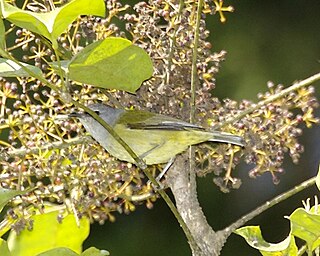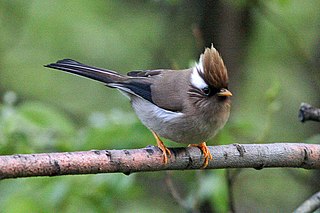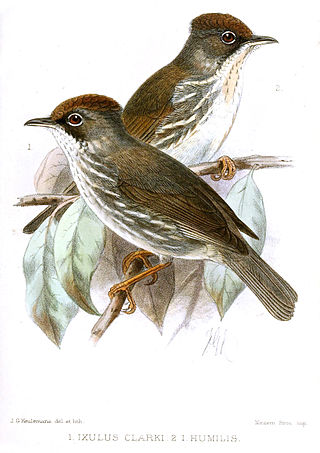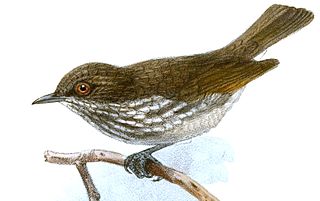
The white-eyes are a family, Zosteropidae, of small passerine birds native to tropical, subtropical and temperate Sub-Saharan Africa, southern and eastern Asia, and Australasia. White-eyes inhabit most tropical islands in the Indian Ocean, the western Pacific Ocean, and the Gulf of Guinea. Discounting some widespread members of the genus Zosterops, most species are endemic to single islands or archipelagos. The silvereye, Zosterops lateralis, naturally colonised New Zealand, where it is known as the "wax-eye" or tauhou ("stranger"), from 1855. The silvereye has also been introduced to the Society Islands in French Polynesia, while the Japanese white-eye has been introduced to Hawaii.

The flame-templed babbler is a species of bird of the family Zosteropidae, in the genus Dasycrotapha. It is one of the most remarkable and distinctive birds with its complex head markings with orange crown tufts, black ears and yellow beak and face. It is endemic to the Philippines, where it is found on the islands of Panay and Negros. Its natural habitat is tropical moist lowland forest. It is threatened by habitat loss. Along with the Negros striped babbler, it is one of the two babbler species extremely sought after by birdwatchers on Negros.

Heleia is a genus of birds in the white-eye family Zosteropidae. One species, the spot-breasted heleia is restricted to the island of Timor. The pygmy white-eye is endemic to the island of Borneo. The thick-billed heleia, occurs on Flores and Sumbawa.

The pygmy cupwing or pygmy wren-babbler, is a species of bird in the Pnoepyga wren-babblers family, Pnoepygidae. It is found in southern and eastern Asia from the Himalayas to the Lesser Sunda Islands. Its natural habitats are subtropical or tropical moist lowland forest and subtropical or tropical moist montane forest.

The rusty-crowned babbler is a species of bird in the family Zosteropidae. It is native to the southern Philippines on the islands of Mindanao and Dinagat Islands and Basilan. Its natural habitat is tropical moist lowland forest.

The Palawan striped babbler is a species of bird in the family Zosteropidae. It is one of the four striped babblers along with the Negros striped babbler, Panay striped babbler and Luzon striped babbler. It is endemic to the Philippines, where it is only found in Palawan. Its natural habitat is tropical moist montane forest. It is threatened by habitat loss.

The Mindanao pygmy babbler is a bird species endemic to the Philippines. It had been placed in the family Timaliidae, but it is a close relative of the white-eyes, however, and many taxonomists now place it in the family Zosteropidae..

The Luzon striped babbler is a species of bird in the family Zosteropidae. It is one of the four striped babblers along with the Negros striped babbler, Panay striped babbler and Palawan striped babbler. It is endemic to the Philippines, where it is only found in northern Luzon and in Bataan. Its natural habitat is tropical moist lowland forest. It is threatened by habitat loss.

The white-naped yuhina is a bird species in the white-eye family Zosteropidae.

Yuhina is a genus of birds in the white-eye family Zosteropidae.

The striated yuhina is a bird species in the white-eye family Zosteropidae.

The white-collared yuhina is a bird species in the white-eye family Zosteropidae.

The stripe-throated yuhina is a bird species in the white-eye family Zosteropidae.

The Burmese yuhina is a species of bird in the family Zosteropidae. It is found in Myanmar and Thailand. Its natural habitat is subtropical or tropical moist montane forests.

The black-chinned yuhina is a bird species in the white-eye family Zosteropidae.

The rufous-vented yuhina is a bird species in the white-eye family Zosteropidae. It is found along the northern parts of the Indian subcontinent, primarily in the Eastern Himalayas, and ranges across Bhutan, India, Tibet, Myanmar, and Nepal. Its natural habitat is subtropical or tropical moist montane forests.

Sterrhoptilus is a songbird genus recently separated from Stachyris. It used to be placed in the family Timaliidae. With other "Old World babblers" of the genus Yuhina, it was recently determined to be better placed in the family Zosteropidae.

Zosterornis is a genus of passerine birds in the white-eye family Zosteropidae. The five species in the genus are endemic to the Philippines.

The Visayan pygmy babbler is a bird species endemic to the Philippines on the islands of Leyte and Samar. It was conspecific with the Mindanao pygmy babbler under the common name of "pygmy babbler".Its natural habitats are tropical moist lowland forests and or tropical moist montane forests.



















